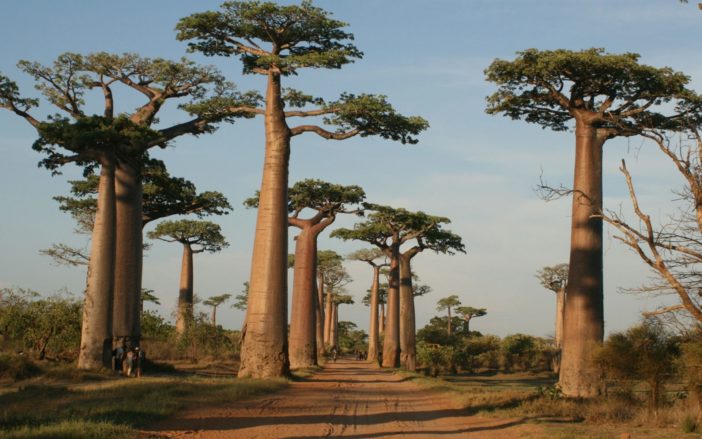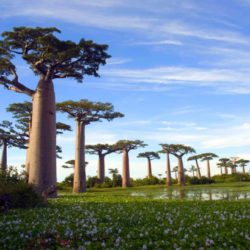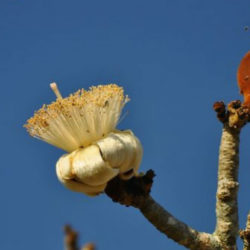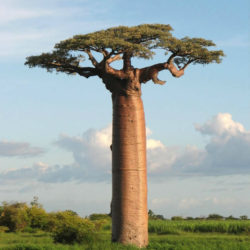Scientific Name
Adansonia grandidieri Baill.
Common Name(s)
Giant Baobab, Grandidier's Baobab
Scientific Classification
Family: Malvaceae
Subfamily: Bombacoideae
Genus: Adansonia
Origin
This species is native to southwestern Madagascar.
Description
Adansonia grandidieri is a magnificent tree with a massive cylindrical trunk topped with a flat-topped crown with a few horizontal main branches that bear bluish-green palmate leaves densely covered with star-shaped hairs. It grows up to 100 feet (30 m) tall and is the most beautiful of the Baobabs. The trunk is up to 10 feet (3 m) in diameter and covered with smooth reddish-grey bark. Leaves typically have 9 to 11 leaflets.
The spectacular flowers with white petals appear during the dry season before the leaves appear. Fruits are large, rounded to ovoid with a hard shell, covered with dense reddish-brown hairs, and contain numerous large, kidney-shaped seeds within an edible pulp.

Hardiness
USDA hardiness zones 10a to 11b: from 30 °F (−1.1 °C) to 50 °F (+10 °C).
How to Grow and Care
Baobabs are quite easily grown from seed, although seldom available in nurseries. Seed can be collected from dry fruits by cracking the fruit, opening, and washing away the dry, powdery coating. The dark brown to black, kidney-shaped seeds should be soaked in a container of hot water and allowed to cool, and they may then be sown after soaking for 24 hours. Sowing the seeds in spring and summer in a well-drained seedling mixture containing 1/3 sand is best.
Cover the seed with sand to a depth of 0.15 to 0.25 inches (4 to 6 mm), place the trays in a warm semi-shaded position, and water regularly until the seeds have all germinated. Germination may take from 2 to 6 weeks. Seedlings should be carefully monitored for damping-off fungus, which can be treated with a fungicidal drench.
Transplant the seedlings once they are 2 inches (5 cm) tall into individual containers, preferably in sandy soil with some well-rotted compost and bone meal. Baobabs grow reasonably quickly when they are young.
See more at Baobab: The Largest Succulent Plant in the World.
Links
- Back to genus Adansonia
- Succupedia: Browse succulents by Scientific Name, Common Name, Genus, Family, USDA Hardiness Zone, Origin, or cacti by Genus
Photo Gallery
Click on a photo to see a larger version.


